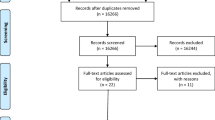Abstract
For some time, corrections researchers have focused on the punitive and rehabilitative orientations of correctional officers. Relatively little research attention, however, has been devoted to understanding the support for these orientations among correctional workers responsible for the care and custody of juvenile delinquents. Based on survey data drawn from a sample of detention care workers (DCWs) in two facilities in a Southeastern state (N=109), this paper examines the extent to which, and why, DCWs adopt a punitive orientation to youth in detention despite policies and training that discourage this view. Findings, that contrast the relative impact of demographic, occupational/professional and organizational environment variables in accounting for variation in punishment/control orientation among DCWs, suggest that demographic indicators (i.e., age, gender) and organizational environment contribute disproportionately to explained variance in punitive orientation once other variables are controlled. Implications for detention policy, staff recruitment and training are discussed.
Similar content being viewed by others
References
Bartollas, C., Miller, S.J., & Dinitz, S. (1976).Juvenile victimization: The institutional paradox. New York: Halstead.
Bazemore, G., Dicker, T.J., & Nyhan, R. (1994). Juvenile justice reform and the difference it makes: An exploratory study of the impact of policy change on detention worker attitudes.Crime & Delinquency, 40, 37–53.
Cohen, L.E. (1975).Delinquency dispositions: An empirical analysis of processing decisions in three juvenile courts. Washington, DC: U.S. Government Printing Office.
Crouch, B., & Alpert, G. (1982). Sex and occupational socialization among prison guards: A longitudinal study.Criminal Justice and Behavior, 9, 159–76.
Cullen, F.T. (1989). The correctional orientation of prison guards: Do officers support rehabilitation?Federal Probation, 53, 33–42.
Cullen, F.T., Gilbert, K.E., & Cullen, J.B. (1983). Implementing determinate sentencing in Illinois: Conscious and convenient.Criminal Justice Review, 8, 1–16.
Cullen, F.T., Latessa, E.J., Burton, V.S., Jr., & Lombardo, L.X. (1993). The correctional orientation of prison wardens: Is the rehabilitative ideal supported?Criminology, 31, 69–92.
Cullen, F.T., Link, B.G., Wolfe, N.T., & Frank, J. (1985). The social dimensions of correctional officer stress.Justice Quarterly, 2, 505–533.
Dale, M.J., & Sanniti, C. (1993). Litigation as an instrument for change in juvenile detention: A case study.Crime & Delinquency, 39, 49–68.
Dembo, R., & Dertke, M. (1986). Work environment correlates of staff stress in a youth detention facility.Criminal Justice and Behavior, 17, 328–344.
Feld, B.C. (1977).Neutralizing inmate violence: Juvenile offenders in institutions. Cambridge, MA: Ballinger.
Feld, B.C. (1991).Transformed but unreformed: Juvenile court and the criminal alternative. Minneapolis, MN: University of Minnesota Law School.
Frazier, C.F. (1989). Preadjucatory detention. In A. R. Roberts (Ed.),Juvenile justice: Policies, programs, and services (pp. 143–162). Chicago: Dorsey.
Frazier, C.F., & Bishop, D. (1985). The pre-trail detention of juveniles and its impact on case dispositions.Journal of Criminal Law and Criminology, 76, 301–321.
Frazier, C.F., & Cochran, J.K. (1986). Detention of juveniles: Its effects on subsequent juvenile court processing decisions.Youth and Society, 17, 286–305.
Hepburn, J.R. (1987). The prison control structure and its effects on work attitudes: The perceptions and attitudes of prison guards.Journal of Criminal Justice, 15, 49–64.
Hepburn, J.R., & Albonetti, C. (1980). Role conflict in correctional institutions.Criminology, 17, 445–59.
Joyce, W.F., & Slocum, J.W. (1984). Collective climate: Agreement as a basis for defining aggregate climates in organizations.Academy of Management Journal, 27, 721–742.
Jurik, N.C. (1985). Individual and organizational determinants of correctional officer attitudes toward inmates.Criminology, 23, 523–539.
Klofas, J. (1986). Discretion among correctional officers: The influence of urbanization, age, and race.International Journal of Offender Therapy and Comparative Criminology, 30, 11–24.
Klofas, J., & Toch, H. (1982). The guard subculture myth.Journal of Research In Crime and Delinquency, 19, 238–254.
Krisberg, B., Thornberry, T., & Austin, J. (1989).Juveniles taken into custody: Developing national statistics. San Francisco: National Council on Crime and Delinquency.
Lombardo, L.X. (1989).Guard imprisoned: Correctional officers at work. New York: Elsevier.
Lotz, R.E., Poole, D., & Regoli, R.M. (1985).Juvenile delinquency and juvenile justice. New York: Random House.
Melvin, K. B., Gramling, L. K., & Gardner, W. M. (1985). A scale to measure attitudes toward prisoners.Criminal Justice and Behavior, 12, 241–253.
Norman, M.D., & Burbidge, G.S. (1991). Attitudes of youth corrections professionals toward juvenile justice reform and policy alternatives: A Utah survey.Journal of Criminal Justice, 19, 81–91.
Parker, D.F., & DeCotis, T.A. (1983). Organizational determinants of job stress.Organizational Behavior and Human Performance, 32, 160–177.
Poole, E.D., & Pogrebin, M.R. (1988). Deputy sheriffs as jail guards: A study of correctional policy orientations and career phases.Criminal Justice and Behavior, 15, 190–209.
Poole, E.D., & Regoli, R.M. (1980). Role stress, custody orientation and disciplinary actions: A study of prison guards.Criminology, 18, 215–226.
Sarri, R. (1974).Under lock and key: Juveniles in jail and detention: National assessment of juvenile corrections. Ann Arbor: University of Michigan.
Schein, E.H. (1985).Organizational culture and leadership. San Francisco: Jossey-Bass.
Schneider, B., & Rentsch, J.R. (1988). Managing climates and cultures: A futures perspective. In J. Hage (Ed.),Futures of organizations (pp. 181–200). Lexington, MA: Lexington Books.
Schwartz, I., Fishman, G., Hatfleld, R., Krisberg, B., & Eisikovitz, E. (1987). Juvenile detention: The hidden closet revisited.Justice Quarterly, 4, 219–235.
Schwartz, I., & Van Vleet, R. (1992). Public policy and the incarceration of juveniles. In I. Schwartz (Ed.),Juvenile justice and public policy (pp. 151–164). New York: Lexington Books.
Shamir, B., & Drory, A. (1982). Occupational tedium among prison officers.Criminal Justice and Behavior, 9, 79–99.
Sluder, R.D., Shearer, R., & Potts, D. (1991). Probation officers’ role perceptions and attitudes toward firearms.Federal Probation, 55, 3–11.
Tabachnick, B.G., & Fidell, L.S. (1983).Using multivariate statistics. New York: Harper and Row.
Whitehead, J.T., & Lindquist, C.A. (1989). Determinants of correctional officers’ professional orientation.Justice Quarterly, 6, 69–85.
Whitehead, J.T., & Lindquist, C.A. (1992). Determinants of probation and parole officer professional orientation.Journal of Criminal Justice, 20, 13–14.
Author information
Authors and Affiliations
Rights and permissions
About this article
Cite this article
Bazemore, G., Dicker, T.J. & Al-Gadheeb, H. The treatment ideal and detention reality: Demographic, professional/ occupational and organizational influences on detention worker punitiveness. AJCJ 19, 21–41 (1994). https://doi.org/10.1007/BF02887437
Issue Date:
DOI: https://doi.org/10.1007/BF02887437




